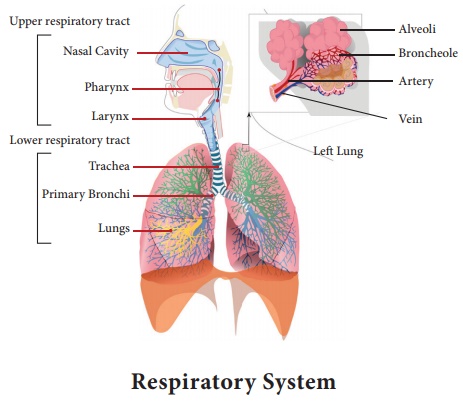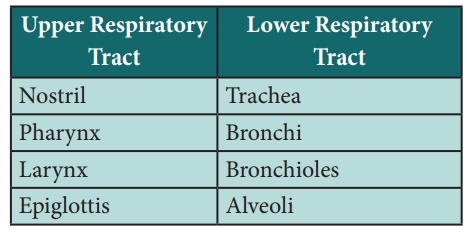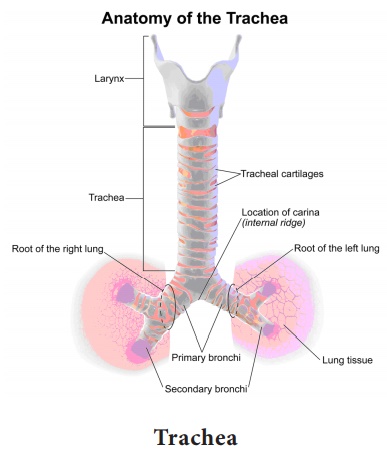Chapter: 12th Nursing : Chapter 1 : Human Anatomy and Physiology
Respiratory system
Respiratory system
Introduction
Respiratory system provides the body with oxygen required to
sustain life and to eliminate carbon dioxide. The respiratory system works in
association with the heart and lungs.
Air is breathed in through the nose or the mouth. In nasal cavity,
a layer of mucus membrane acts as a filter and traps pollutants and other
harmful substances found in the air. Next air moves in to the pharynx, a
passage that contains the intersection between the oesophagus and the larynx.
The opening of the larynx has a special flap of cortilage the epiglottis that
opens to allow air to pass through but closes to prevent food from moving in to
the airway.

From the larynx air moves in to the trachea and down
to the intersection that branches to form the right and left
primary bronchi, each of these bronchi, branch in to secondary
bronchi that branch into tertiary bronchi that branch in to smaller
airways called bronchioles that eventually connect with tiny
specialized structure called alveoli that function in gas exchange.
The respiratory system is divided into the upper and lower
respiratory system.
Nostrils
A nostril is one of the two channels of the nose from the point
where they bifurcate to the external opening.

Pharynx
Pharynx is the part of the throat. It is situated at behind the
nasal cavity, besides the larynx, and above the oesophagus. It has three part,
they are nasopharynx, oropharynx and laryngopharynx.
Epiglotis
Epiglotis is a flap in the throat. It is present between the
pharynx and larynx. It helps to prevent the food from entering the windpipe
[trachea] and the lungs. It is made up of elastic cartilage covered with a mucus
membrane attached to the entrance of the larynx.
Larynx
Adam’s apple or the voice box. Larynx connects the lower part of
the pharynx and trachea. It received inspired air from the pharynx and passes
it to the trachea.
Trachea

Trachea called as windpipe, is a cartilaginous tube that connects
the pharynx and larynx to the lungs allowing the passage of air.
Lungs
The lungs are the primary organs of the respiratory system. Human
lungs are conical in shape and spongy organ. Right and left lung are situated
in the thoracic cavity, either side of the heart, and above the diapharam.
The lungs are protected by ribcage and the spine. The right lung
is larger than left lung. The left lung has two lobes, upper and lower lobes.
The right lung has three lobes upper, middle and the lower lobe.
Bronchus
The bronchus is passage of airway in the respiratory system. They
conducts air in to the lungs. It is divided in to primary, secondary, and
tertiary bronchi.
Bronchioles
They are bronchus of the bronchi. The bronchioles further divided
in to smaller terminal bronchioles.
Alveoli
The alveoli are located in the respiratory zone of the lungs. It
is the smallest units in the respiratory tract. Human lungs contain about 480
million alveoli.

Each alveolus is surrounded by numerous capillaries and is the
site of gas exchange by diffusion.
Respiratory cycle
The respiratory cycle includes two phases, inspiration or
inhaltion of oxygen and expiration or exhalation of carbon dioxide.
The lungs expand with inspiration and deflate and relax during
expiration. Both the expansion and contraction of the lungs are aided by the
muscular diaphragm and the intercostal muscles.
Disease of the respiratory tract
·
Pneumonia
·
Emphysema
·
Bronchitis
·
Asthma
·
Chronic Obstructive Pulmonary Disease (COPD)
·
Influenza or the “flu”
·
Tuberculosis
·
Laryngitis
·
Pharyngitis
·
Lung Cancers
·
Dyspnea
·
Respiratory arrest
Related Topics